Vietnam’s culinary landscape is a vibrant tapestry, a symphony of flavors and textures that tells the story of its geography, history, and people. While famous globally for icons like pho and banh mi, the true depth of Vietnamese food extends far beyond these well-loved dishes. As a passionate explorer of culture through cuisine, I can attest that deciding what to eat in Vietnam is an adventure in itself, a delightful journey from bustling street corners to hidden family kitchens. This guide will take you through some essential dishes, revealing the stories and regional nuances that make Vietnamese food truly special.
Why Vietnamese Cuisine is a Must-Try Experience
Vietnamese cuisine is celebrated for its freshness, balance of flavors (sweet, salty, sour, bitter, spicy), and reliance on fresh herbs and vegetables. Each region boasts its own distinct style. The North favors simplicity and subtle flavors, the Central region is known for its bold spices and elaborate royal dishes, while the South often incorporates more sugar and coconut milk, reflecting its fertile lands and proximity to the Mekong Delta. Eating your way through Vietnam is the best way to understand its diverse cultural identity.
Iconic Dishes: Your Guide to What To Eat In Vietnam
When asking yourself “What To Eat In Vietnam?”, prepare for a list that’s both long and incredibly rewarding. These dishes are more than just food; they are cultural touchstones, often enjoyed communally and deeply ingrained in daily life. Let’s explore some of the must-tries that define the Vietnamese culinary experience.
Phở: The Soulful Noodle Soup
Perhaps the most internationally recognized Vietnamese dish, Phở is a comforting noodle soup that serves as the unofficial national dish. The word “phở” actually refers to the flat rice noodles themselves. The base is a deeply aromatic beef or chicken broth, simmered for hours with warming spices like star anise, cloves, and cinnamon. The most common versions feature thin slices of beef or shredded chicken.
The northern phở Hanoi is typically enjoyed with a clear broth, simply garnished with green onions, cilantro, and a squeeze of lime or vinegar. In contrast, the southern phở Nam (or phở Sài Gòn) features a cloudier, slightly sweeter broth and is served with a generous platter of fresh herbs like basil, mint, bean sprouts, and saw-leaf herb, allowing diners to customize their bowl. Phở is traditionally a breakfast dish, fueling the nation from the early morning.
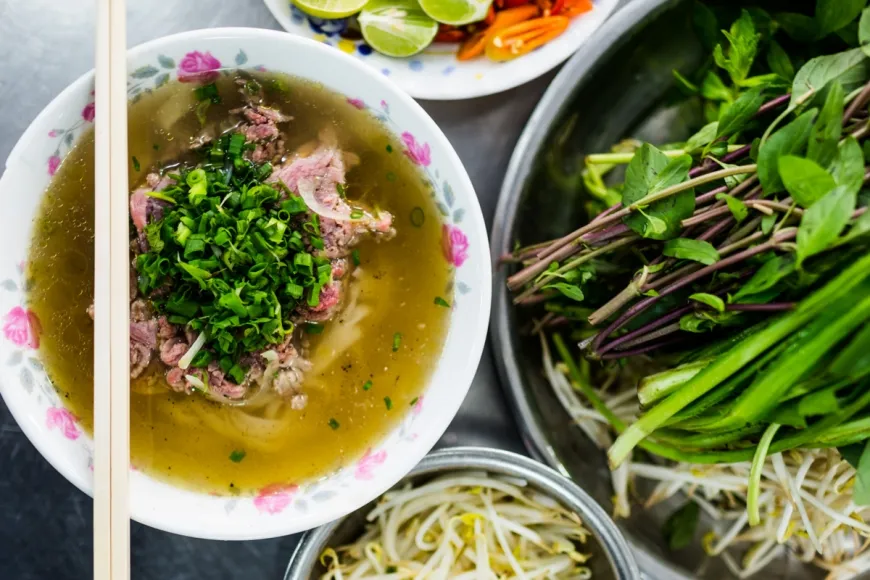 A vibrant bowl of pho, a classic answer to what to eat in Vietnam
A vibrant bowl of pho, a classic answer to what to eat in Vietnam
Try it: Pho Thin (Hanoi) or Pho Hoa (Ho Chi Minh City).
Bánh Mì: A French Twist Turned Vietnamese Icon
The Bánh Mì is a perfect example of culinary adaptation, transforming the French baguette into a uniquely Vietnamese street food sensation. The baguette itself is lighter and airier than its French cousin, with a thin, crispy crust and a soft, chewy interior. It’s typically split and spread with paté and margarine or mayonnaise.
The magic happens with the fillings, which vary but often include savory elements like grilled pork, Vietnamese sausage (chả lụa), shredded chicken, or even sardines in tomato sauce, layered with pickled carrots and daikon, cucumber slices, fresh cilantro, and sometimes pork floss or fried shallots. The contrast of the crunchy bread and the flavorful, varied fillings makes each bite a delightful explosion of textures and tastes. Bánh Mì is a quick, affordable, and utterly satisfying meal any time of day.
Top 15+ Ideas for Unforgettable Family Fun Los Angeles
Discover the Best Backpacking in Michigan – Unforgettable Trails & Adventures
Discover the Best Time to Visit Denver – A Seasonal Guide 2025
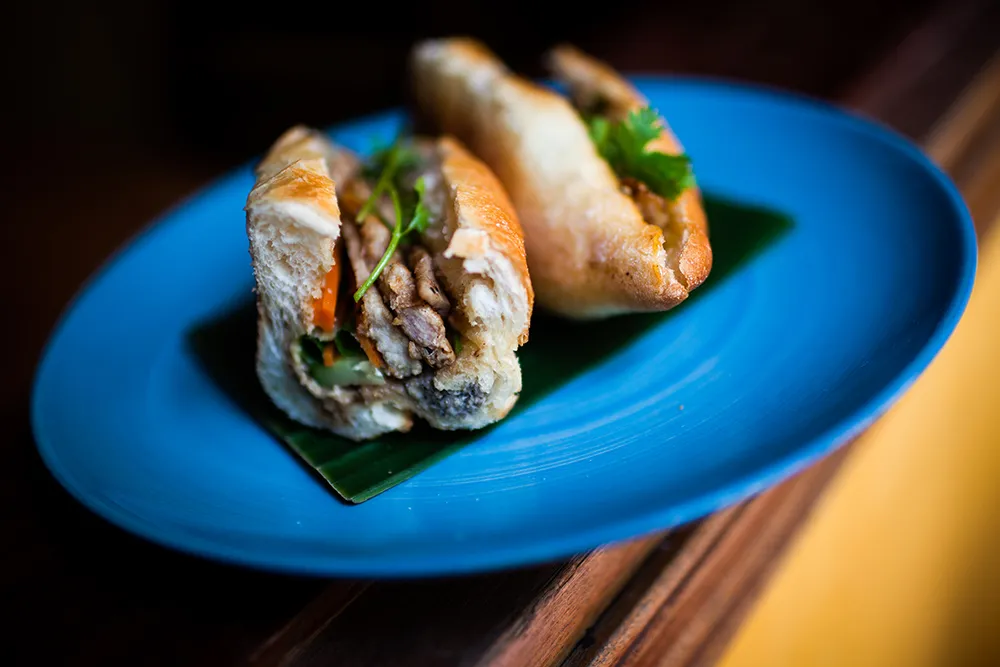 A crispy Banh Mi sandwich filled with savory ingredients, a quintessential item when deciding what to eat in Vietnam
A crispy Banh Mi sandwich filled with savory ingredients, a quintessential item when deciding what to eat in Vietnam
Try it: Banh My Phuong (Hoi An) is famously delicious.
Cơm Tấm: The Humble Broken Rice Dish
Originating from the days when farmers would eat the fractured rice grains that couldn’t be sold, Cơm Tấm (broken rice) has become a beloved staple, especially in the South. Despite its humble beginnings, a plate of Cơm Tấm is anything but plain, often featuring a variety of decadent toppings.
The most popular rendition is cơm tấm sườn nướng ốp la, featuring broken rice topped with a perfectly grilled, marinated pork chop and a sunny-side-up fried egg. It’s typically dressed with nước chấm, the ubiquitous Vietnamese dipping sauce (fish sauce, sugar, lime, chili), and a drizzle of scallion oil (mỡ hành). Pickled vegetables, fresh cucumber and tomato slices, and sometimes crispy fried pork rinds or shallots complete this hearty and flavorful dish, showcasing how simple ingredients can be elevated into a satisfying meal.
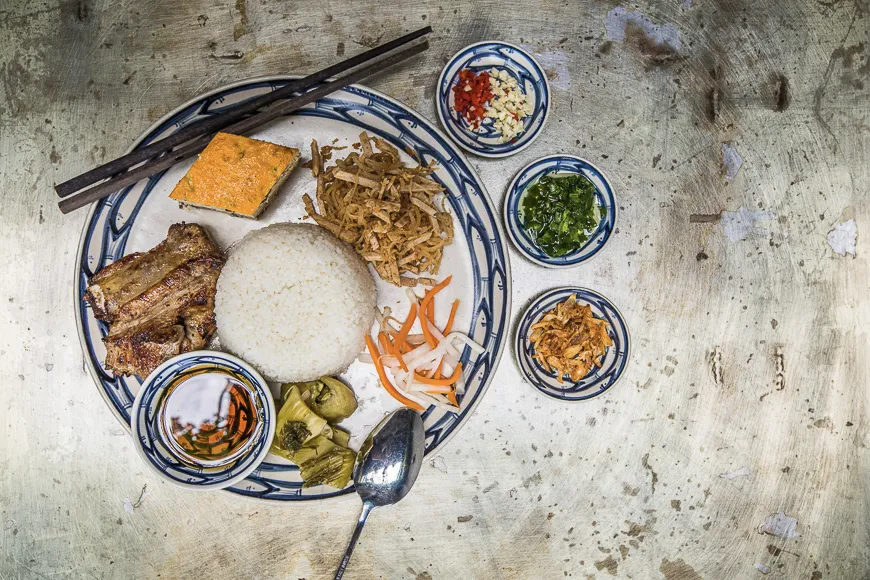 A plate of Com Tam, broken rice with grilled pork and egg, a must-eat in Vietnam
A plate of Com Tam, broken rice with grilled pork and egg, a must-eat in Vietnam
Try it: Look for family-operated stalls in Ho Chi Minh City, like one on Vo Van Tan Street.
Bún Bò Huế: Spicy Royalty from Hue
From the former imperial capital of Hue comes Bún Bò Huế, a noodle soup known for its complex flavors and spicy kick. The broth is a rich, fragrant base made from simmering beef bones with a generous amount of lemongrass, shrimp paste, and chili oil, giving it a distinctive reddish hue.
The soup is filled with thick rice vermicelli noodles (bún), tender slices of beef shank, and often includes pork knuckles, cubes of congealed pig blood (optional, ask to omit if squeamish), and slices of chả lụa (Vietnamese ham sausage). Served with a platter of fresh herbs, bean sprouts, and banana blossom, Bún Bò Huế is a bold and exhilarating culinary experience that perfectly represents the refined yet robust cuisine of Central Vietnam.
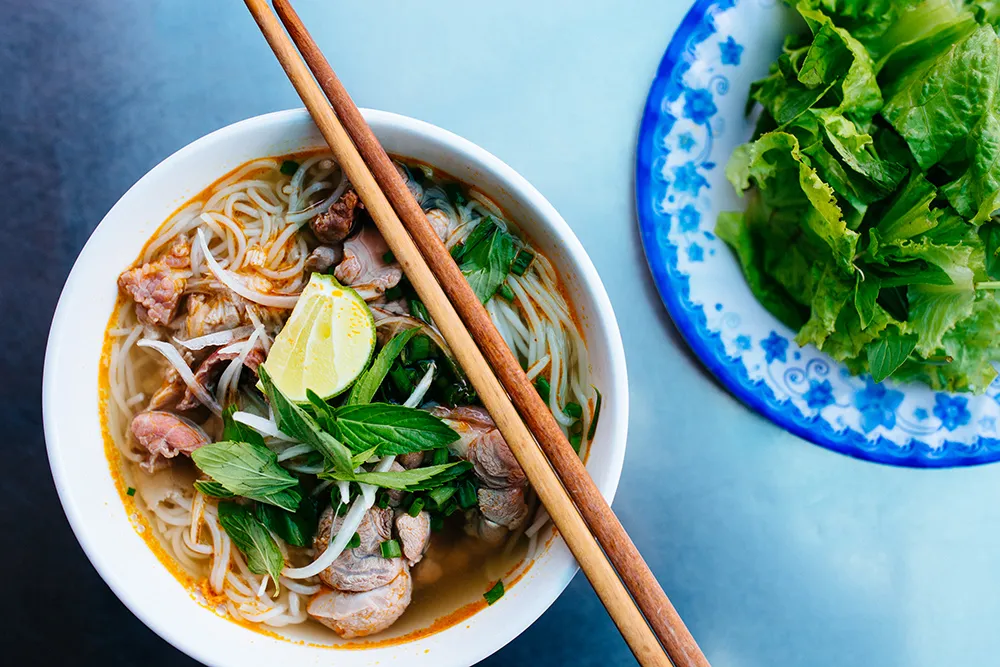 A vibrant bowl of Bun Bo Hue, a spicy and flavorful noodle soup to try when deciding what to eat in Vietnam
A vibrant bowl of Bun Bo Hue, a spicy and flavorful noodle soup to try when deciding what to eat in Vietnam
Try it: Quan Bun Bo Hue in Hue is a popular spot.
Cao Lầu: Hoi An’s Unique Culinary Secret
Unique to the ancient trading port town of Hoi An, Cao Lầu is a noodle dish shrouded in legend and history, reflecting Chinese, Japanese, and Vietnamese influences. Its most distinctive element is the thick, chewy noodles, which are said to require water from the thousand-year-old Ba Le well and ash from certain trees on Cham Island to achieve their perfect texture and slightly grey color.
The dish consists of these special noodles topped with slices of char siu-like pork (influenced by Chinese BBQ), fresh herbs, bean sprouts, and crispy pork cracklings or croutons, all tossed in a small amount of flavorful broth or sauce. It’s neither quite a soup nor a dry noodle dish, sitting somewhere in between. The blend of textures and the subtle, savory flavor make Cao Lầu a truly unique and essential part of the Hoi An food experience.
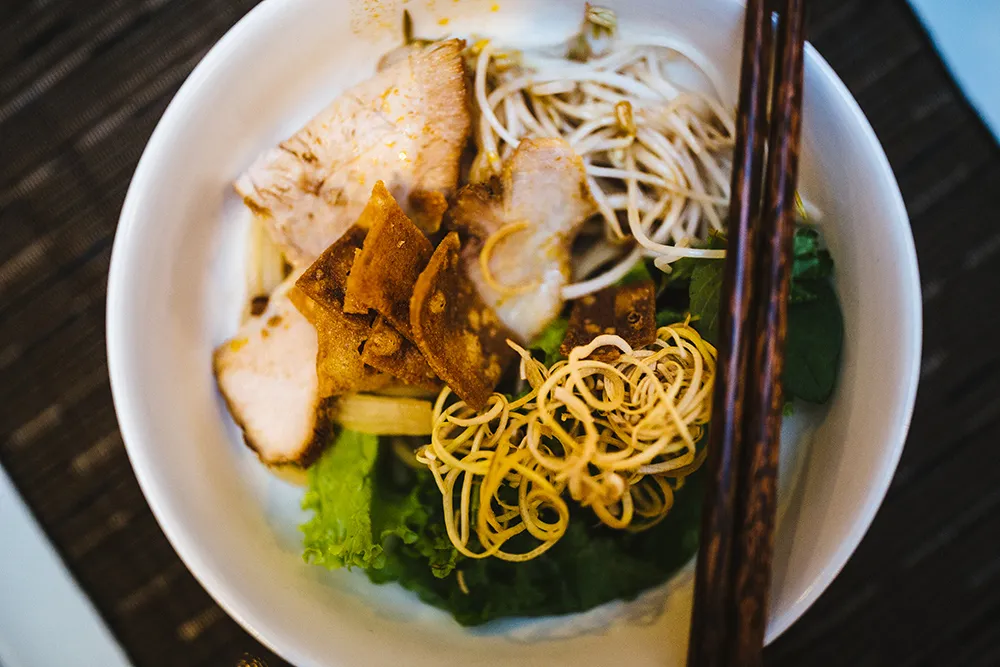 A bowl of Cao Lau noodles, a specialty dish from Hoi An and a must-try when exploring what to eat in Vietnam
A bowl of Cao Lau noodles, a specialty dish from Hoi An and a must-try when exploring what to eat in Vietnam
Try it: Thanh Cao Lau or look for local vendors in Hoi An’s markets.
Cơm Gà Hội An: Golden Chicken Rice Perfection
Another specialty of Hoi An, Cơm Gà (chicken rice) is a comforting dish elevated by the use of fresh, local ingredients and skillful preparation. The rice is cooked in chicken broth with turmeric and sometimes pandan leaves, giving it a beautiful golden hue and fragrant aroma.
Tender boiled or poached chicken is shredded and mixed with onions, Vietnamese coriander, and a light dressing before being served atop the fragrant rice. Accompaniments often include pickled vegetables (like carrots and daikon), fresh herbs, and a small bowl of the chicken broth on the side. The dish is simple yet incredibly flavorful, showcasing the quality of the ingredients and the Vietnamese talent for balancing flavors.
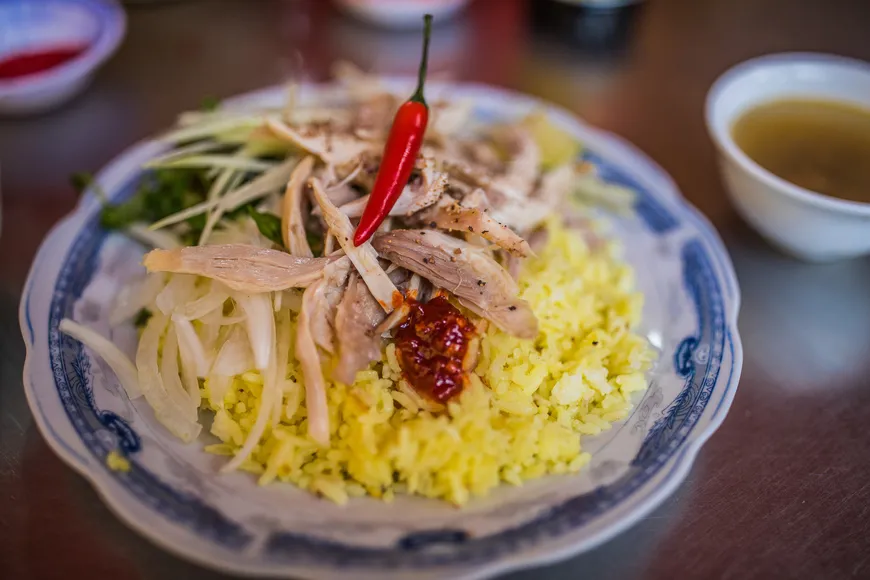 A plate of Com Ga Hoi An, fragrant chicken rice, a delicious option for what to eat in Vietnam
A plate of Com Ga Hoi An, fragrant chicken rice, a delicious option for what to eat in Vietnam
Try it: Com Ga Hien is a well-regarded spot in Hoi An.
Mì Quảng: The Vibrant Central Vietnamese Noodle Dish
Hailing from the Quang Nam province (which includes Da Nang and Hoi An), Mì Quảng is a noodle dish known for its minimal, flavorful broth and vibrant yellow noodles. The flat, wide rice noodles get their color from turmeric and are served in a small amount of rich, savory broth often made with pork and shrimp, seasoned with fish sauce, black pepper, and peanut oil.
Toppings vary widely but commonly include shrimp, pork belly, chicken, boiled quail eggs, and crushed peanuts. Mì Quảng is served with a generous pile of fresh herbs (mint, basil, Vietnamese coriander), sliced banana blossoms, and often accompanied by crispy toasted sesame rice crackers (bánh tráng mè), which are broken into the bowl for added texture. Its unique structure – more broth than sauce, less broth than soup – makes it stand out.
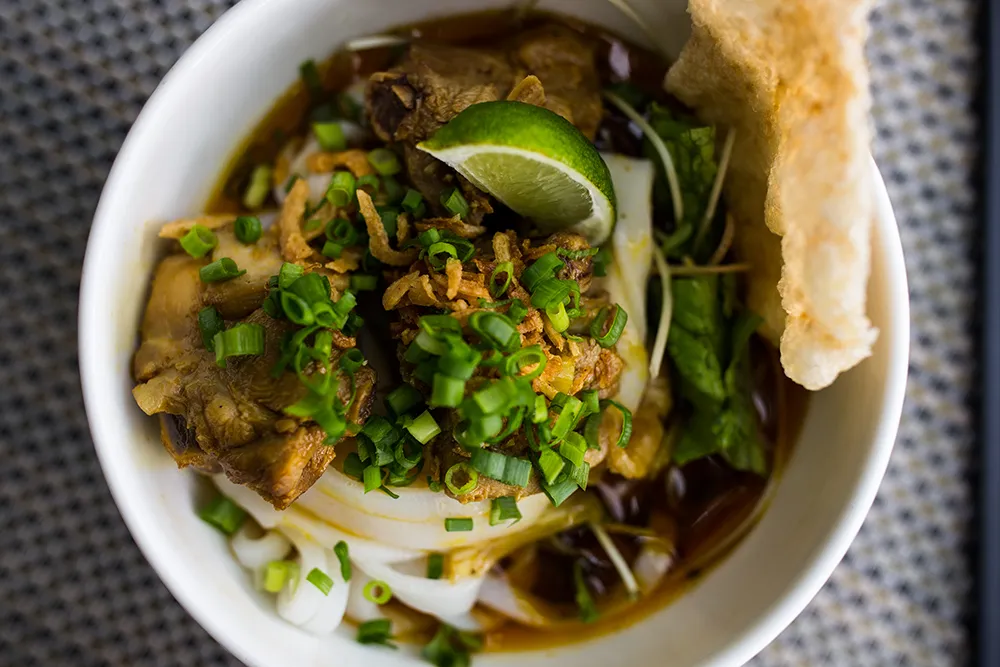 A bowl of Mi Quang noodles, a flavorful Central Vietnamese dish to explore when considering what to eat in Vietnam
A bowl of Mi Quang noodles, a flavorful Central Vietnamese dish to explore when considering what to eat in Vietnam
Try it: Quan Mi Quang Ba Mua is a famous spot in Da Nang.
Bánh Xèo: The Sizzling Savory Pancake
Named for the sizzling sound (xèo) the batter makes when it hits the hot pan, Bánh Xèo is a crispy, savory crepe or pancake popular in Central and Southern Vietnam. The thin batter is traditionally made from rice flour, coconut milk, and turmeric, giving it a distinctive yellow color.
The pancake is filled with ingredients like boiled pork slices, shrimp, bean sprouts, and sometimes mung beans. Once cooked until crispy, it’s folded in half like a giant taco. Eating Bánh Xèo is an interactive experience: you break off a piece, wrap it in lettuce leaves or rice paper with fresh herbs (like mint, basil, and perilla leaf), and dip it into nước chấm. The combination of the crispy exterior, savory filling, fresh herbs, and dipping sauce is incredibly addictive.
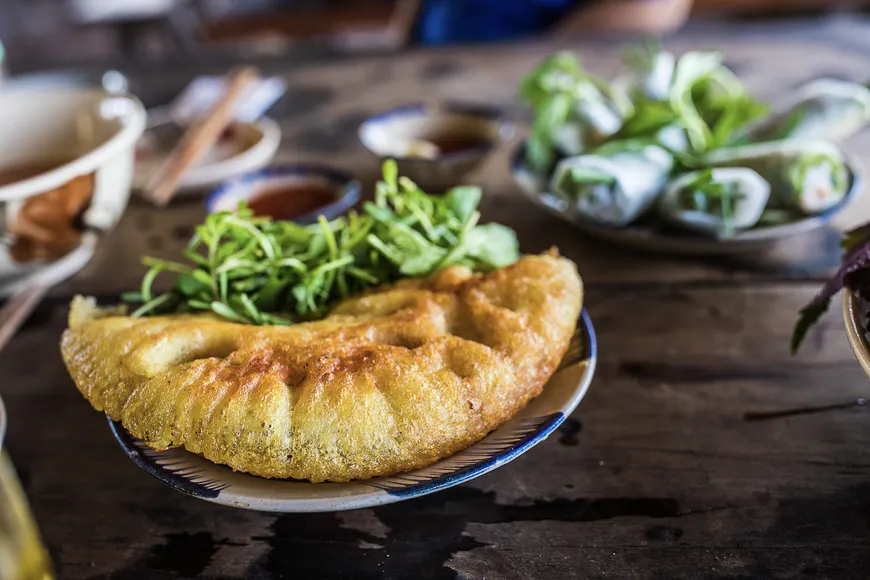 A crispy Banh Xeo pancake, a delicious savory dish to try in Vietnam
A crispy Banh Xeo pancake, a delicious savory dish to try in Vietnam
Try it: Banh Xeo 46A in Ho Chi Minh City is a well-known place.
Bún Chả: Hanoi’s Grilling Street Star
A quintessential Hanoi dish, Bún Chả gained international fame when featured with Anthony Bourdain and President Obama. At lunchtime in Hanoi, the aroma of grilled pork wafts through the streets, leading you to this popular dish.
Bún Chả consists of three main components served separately: a bowl of warm, sweet and sour dipping sauce (nước chấm) containing grilled seasoned pork patties (chả) and slices of marinated grilled pork belly (nem or thịt nướng); a plate of cold rice vermicelli noodles (bún); and a generous basket of fresh herbs and salad greens (lettuce, perilla leaf, mint, cilantro, sometimes sliced morning glory or banana blossom). The eating method is to dip small bundles of noodles, herbs, and pork into the communal bowl of dipping sauce.
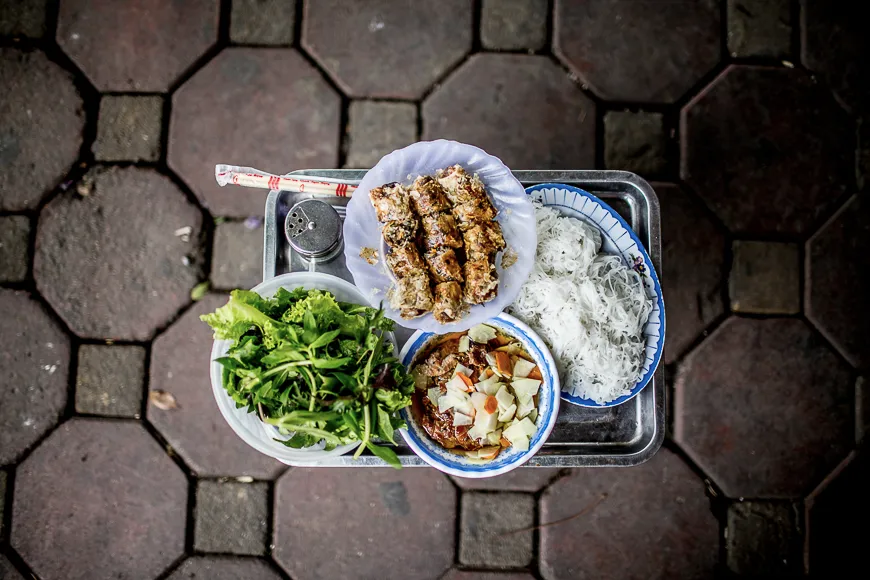 A spread of Bun Cha, grilled pork with vermicelli noodles, a must-try in Hanoi when exploring what to eat in Vietnam
A spread of Bun Cha, grilled pork with vermicelli noodles, a must-try in Hanoi when exploring what to eat in Vietnam
Try it: Bun Cha Huong Lien (now famously known as Bun Cha Obama) in Hanoi.
Xôi: The Versatile Sticky Rice
Xôi, or Vietnamese sticky rice, is a popular and versatile dish enjoyed both sweet and savory, often for breakfast or as a snack. Unlike other sticky rice preparations in the region, Vietnamese Xôi is typically denser and more substantial.
Xôi mặn (savory sticky rice) can be topped with a variety of ingredients like fried shallots, pork floss, dried shrimp, Vietnamese sausage, or even grilled chicken or pork. Xôi ngọt (sweet sticky rice) comes in numerous forms, often flavored and colored naturally with ingredients like pandan (green), gấc fruit (red), corn, or mung beans. The visually stunning xôi ngũ sắc (five-colored sticky rice) uses natural extracts to create vibrant purple, green, red, yellow, and white layers, representing the five elements.
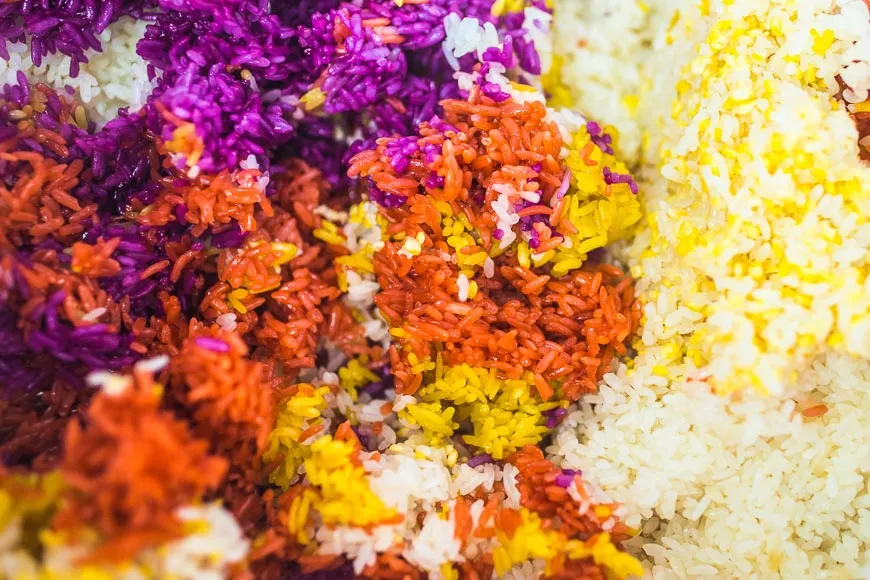 A vibrant dish of Xoi, Vietnamese sticky rice, a versatile option for breakfast or snack when considering what to eat in Vietnam
A vibrant dish of Xoi, Vietnamese sticky rice, a versatile option for breakfast or snack when considering what to eat in Vietnam
Try it: Xoi Yen in Hanoi is famous for its savory versions.
Bánh Bèo: Delicate Steamed Rice Cakes
Bánh Bèo are small, delicate steamed rice cakes, often served as an appetizer or snack, particularly associated with the cuisine of Hue in Central Vietnam. These tiny, slightly chewy disks are typically steamed in individual small saucers or molds, giving them a characteristic shape with a slight indentation in the center.
Each cake is topped with a spoonful of creamy mung bean paste, crispy fried shrimp flakes, and often crunchy fried pork fat (tép mỡ) or croutons. They are served with a special light dipping sauce (nước chấm) that you often pour directly over the cakes in their saucers before eating them with a spoon. Their bite-sized nature and varied textures make them a popular communal dish.
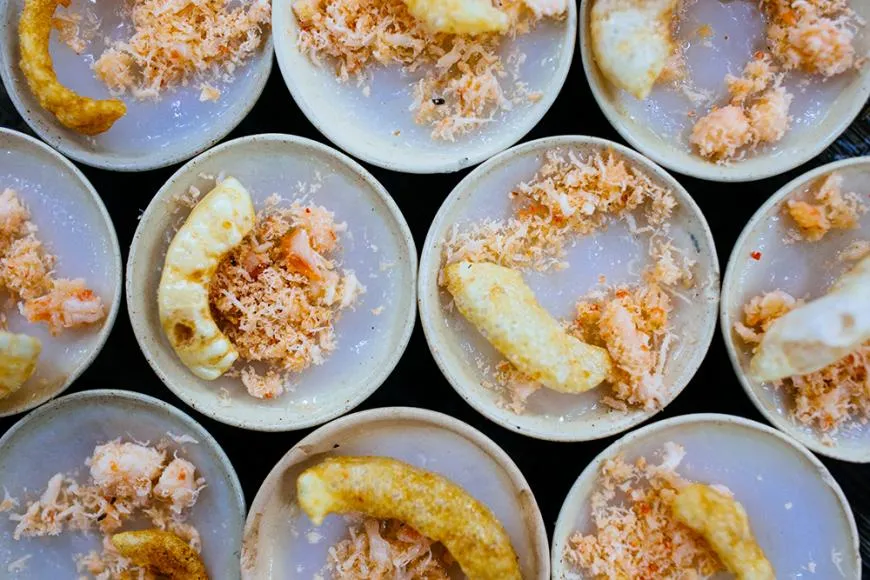 Small bowls of Banh Beo, delicate steamed rice cakes from Hue, a delightful appetizer for what to eat in Vietnam
Small bowls of Banh Beo, delicate steamed rice cakes from Hue, a delightful appetizer for what to eat in Vietnam
Try it: Quan Hanh in Hue offers a variety of Hue specialties including Bánh Bèo.
Bún Riêu: The Tangy Crab Noodle Soup
Bún Riêu is a popular rice vermicelli soup known for its distinctive tangy and savory broth. The base is typically made from a combination of crab paste, tomatoes, and sometimes pork bones, creating a bright, slightly sour flavor profile.
The soup is filled with bún (rice vermicelli), fresh or minced crab meat, cubes of fried tofu, and sometimes snails (ốc) or fish cakes. A key component is the “crab paste” mixture, often made from minced crab combined with egg and ground pork, which forms delicate, melt-in-your-mouth clusters floating in the broth. Like many Vietnamese soups, it’s served with a basket of fresh herbs (perilla, mint, saw-leaf herb) and shredded morning glory or banana blossom, along with lime wedges and chili for customization.
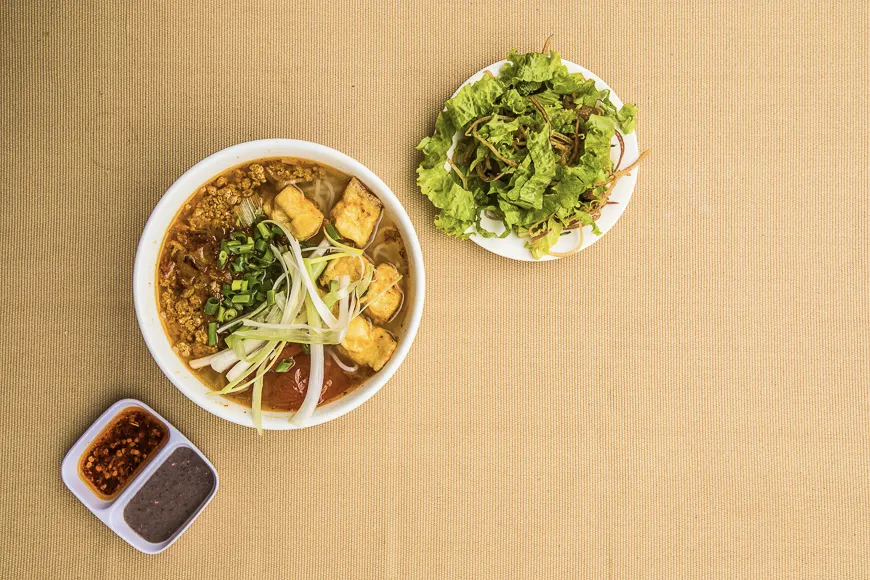 A bowl of Bun Rieu, a tangy crab noodle soup, a unique flavor experience when exploring what to eat in Vietnam
A bowl of Bun Rieu, a tangy crab noodle soup, a unique flavor experience when exploring what to eat in Vietnam
Try it: Bún Riêu Cua Thanh Hồng in Hanoi is a recommended spot.
Gỏi Cuốn: Fresh and Flavorful Summer Rolls
Gỏi Cuốn, also known as summer rolls or fresh spring rolls, are a refreshing and healthy Vietnamese appetizer or snack. Unlike fried spring rolls, these are served fresh. They consist of a medley of ingredients tightly wrapped in softened rice paper wrappers.
Typical fillings include cooked shrimp, slices of pork (often pork belly or tenderloin), rice vermicelli noodles, and a generous amount of fresh herbs like mint, cilantro, and basil, along with crisp lettuce or bean sprouts. A garlic chive often pokes out of the end. Gỏi Cuốn are meant for dipping and are commonly served with either a rich, nutty hoisin-peanut dipping sauce or a lighter nước chấm (fish sauce-based sauce). The balance of textures and fresh flavors makes them incredibly appealing.
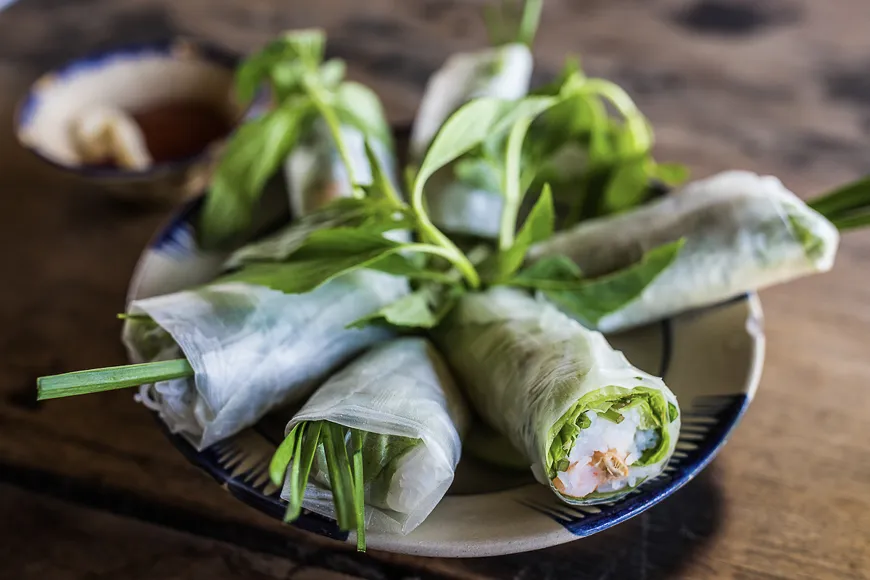 Fresh Goi Cuon, Vietnamese summer rolls, a light and healthy option for what to eat in Vietnam
Fresh Goi Cuon, Vietnamese summer rolls, a light and healthy option for what to eat in Vietnam
Try it: Quan An Ngon in Hanoi offers a wide variety of Vietnamese dishes including Gỏi Cuốn.
Bánh Căn: Mini Savory Pancakes
Bánh Căn are delightful small, round savory pancakes popular in Vietnam’s south-central region, particularly around places like Nha Trang and Phan Rang. They are made from a rice flour batter, often mixed with coconut milk, and cooked in special earthenware molds over charcoal, giving them a crispy bottom and a soft, fluffy interior.
As the batter cooks in the molds, a quail egg is often cracked into the center, and toppings like minced pork, shrimp, or squid are added. The finished cakes are typically served in pairs, often with a bowl of dipping sauce that varies by region but commonly includes fish sauce, green onions, and sometimes meatballs or shredded green mango. The combination of textures – crispy edge, soft center, savory topping – and the flavorful dipping sauce makes them highly addictive.
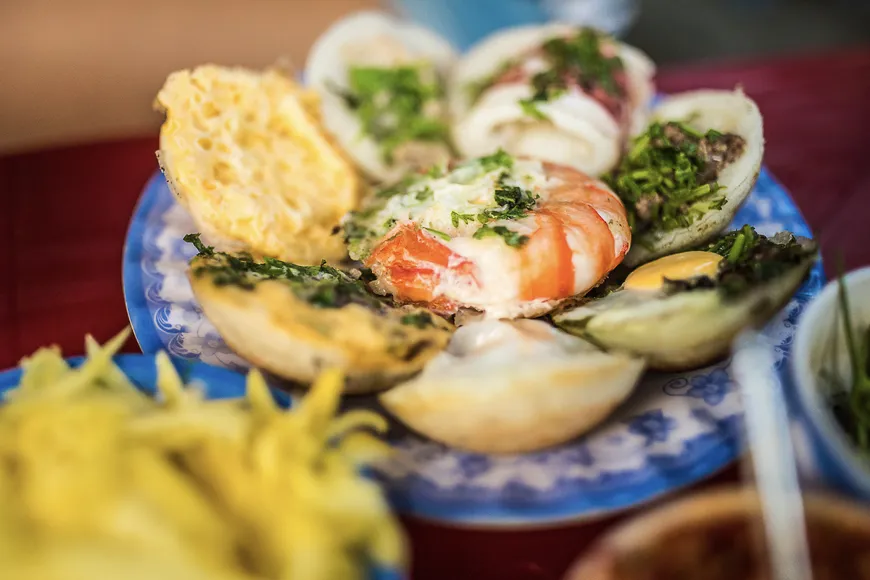 A plate of Banh Can, mini savory pancakes with toppings, a tasty snack or appetizer in Vietnam
A plate of Banh Can, mini savory pancakes with toppings, a tasty snack or appetizer in Vietnam
Try it: Look for local vendors or restaurants specializing in Bánh Căn in south-central coastal cities.
Hủ Tiếu Nam Vang: Southern Noodle Comfort
Hủ Tiếu is a popular noodle soup in Southern Vietnam, with roots in Cambodian cuisine (kuy teav) and Thai cuisine (guay tiew). It typically features thin rice noodles or clear tapioca noodles in a clear, slightly sweet pork broth.
The most famous rendition is Hủ Tiếu Nam Vang, named after Phnom Penh (Nam Vang in Vietnamese). This version is known for its relatively sweet broth (from rock sugar) and generous toppings, which can include sliced pork, pork bones, pork offal (like liver), shrimp, and a quail egg. It’s served with fresh herbs, lettuce, chives, and sometimes fried garlic or shallots. Hủ Tiếu can be enjoyed “wet” (nước), as a soup, or “dry” (khô), where the noodles are served with sauce and toppings on the side, and the broth comes in a separate bowl.
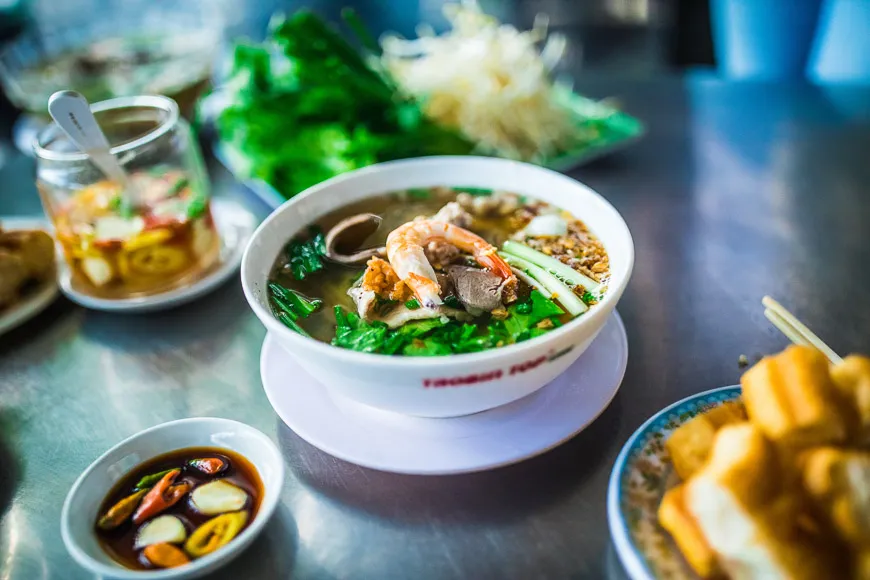 A bowl of Hu Tieu Nam Vang, a popular southern Vietnamese noodle soup to enjoy
A bowl of Hu Tieu Nam Vang, a popular southern Vietnamese noodle soup to enjoy
Try it: Hu Tieu Co Huong in Ho Chi Minh City is a well-regarded spot.
Chả Cá: Hanoi’s Dill & Fish Delight
A unique and beloved specialty of Hanoi, Chả Cá is a dish centered around pan-fried fish marinated in turmeric and galangal, served tableside in a sizzling skillet with copious amounts of fresh dill and green onions.
Chunks of flaky white fish (often snakehead fish or catfish) are marinated until they turn a beautiful yellow hue. At the restaurant, a small portable stove with a pan is brought to your table. The marinated fish is placed in the hot pan with oil or butter, then large amounts of fresh dill and sliced green onions are added and quickly wilted. The dish is typically eaten with rice vermicelli noodles (bún), roasted peanuts, fresh herbs (like cilantro and basil), and a dipping sauce made from mắm tôm (fermented shrimp paste) or nước chấm. It’s a fragrant, textural, and interactive dining experience.
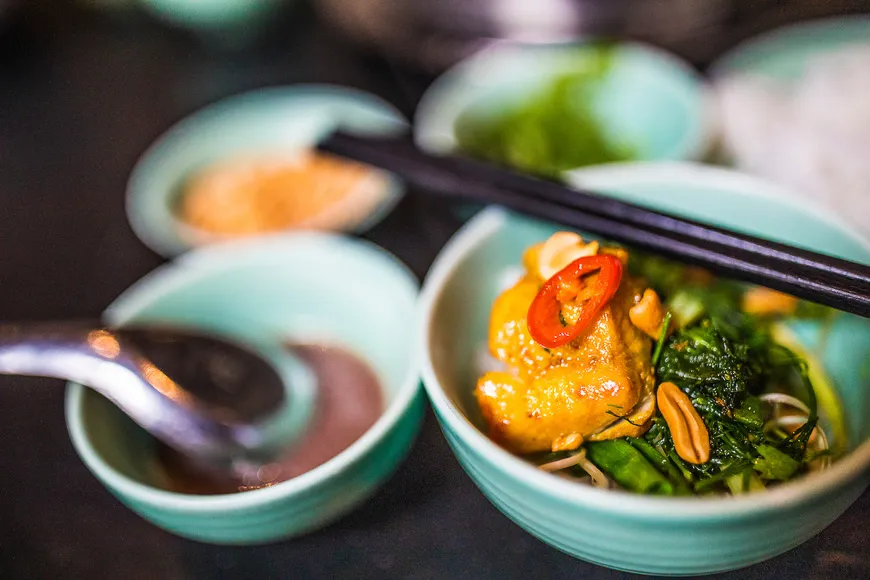 A sizzling skillet of Cha Ca, turmeric fish with dill, a unique Hanoi dish for what to eat in Vietnam
A sizzling skillet of Cha Ca, turmeric fish with dill, a unique Hanoi dish for what to eat in Vietnam
Try it: Cha Ca Thang Long Restaurant in Hanoi is a very popular spot.
Nộm Hoa Chuối: Refreshing Banana Flower Salad
Nộm Hoa Chuối is a beautiful and refreshing Vietnamese salad made primarily from finely shredded banana blossoms. The banana blossom is typically soaked in lime water to remove bitterness before being tossed with a variety of other ingredients and a flavorful dressing.
Common additions include pickled carrots, white onion, cucumber, various fresh herbs (like mint and cilantro), and sometimes shredded chicken, boiled shrimp, or thinly sliced pork for a non-vegetarian version. The dressing is usually a tangy and savory mix based on fish sauce, lime juice, sugar, garlic, and chili. The salad is often topped with crushed roasted peanuts and crispy fried shallots for crunch. It’s a light, bright, and texturally interesting dish, perfect as an appetizer or side.
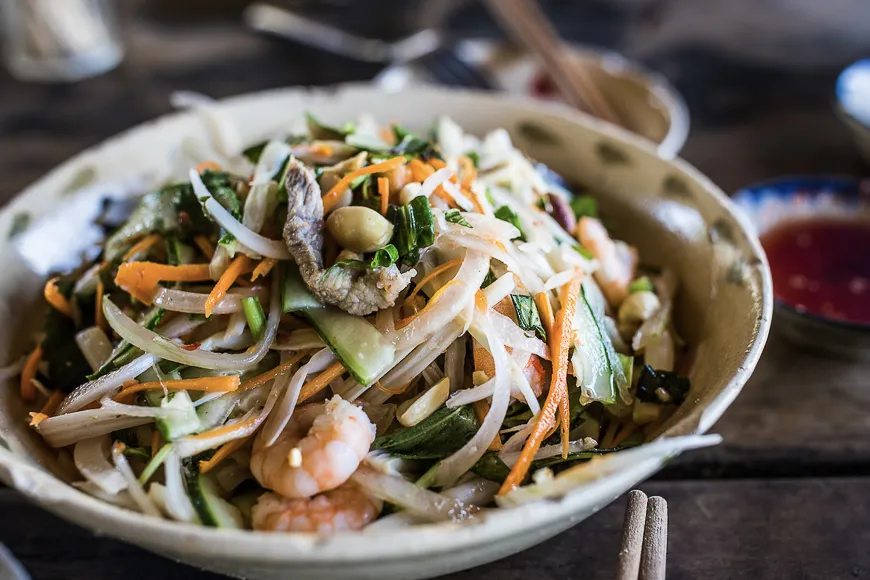 A colorful Nộm Hoa Chuối, Vietnamese banana flower salad, a refreshing choice in Vietnam
A colorful Nộm Hoa Chuối, Vietnamese banana flower salad, a refreshing choice in Vietnam
Try it: Many restaurants serving traditional Vietnamese food will offer this salad. Mountain Retreat in Ho Chi Minh City is known for traditional dishes.
Bánh Cuốn: Steamed Rice Rolls
Bánh Cuốn are delicate, translucent steamed rice flour rolls, typically filled with seasoned minced pork and wood ear mushrooms. The batter, made from rice flour, tapioca starch, and water, is spread thinly over a cloth-covered steamer and quickly cooked before the filling is added and rolled up.
The rolls are served fresh and hot, usually topped with crispy fried shallots and sometimes served alongside Vietnamese pork sausage (chả lụa) or other proteins. The essential accompaniment is a bowl of nước chấm, a dipping sauce that is usually lighter and sweeter than the standard version, sometimes infused with a drop of cà cuống (giant water bug essence) in traditional recipes. Bánh Cuốn is a popular breakfast dish, known for its soft, silky texture.
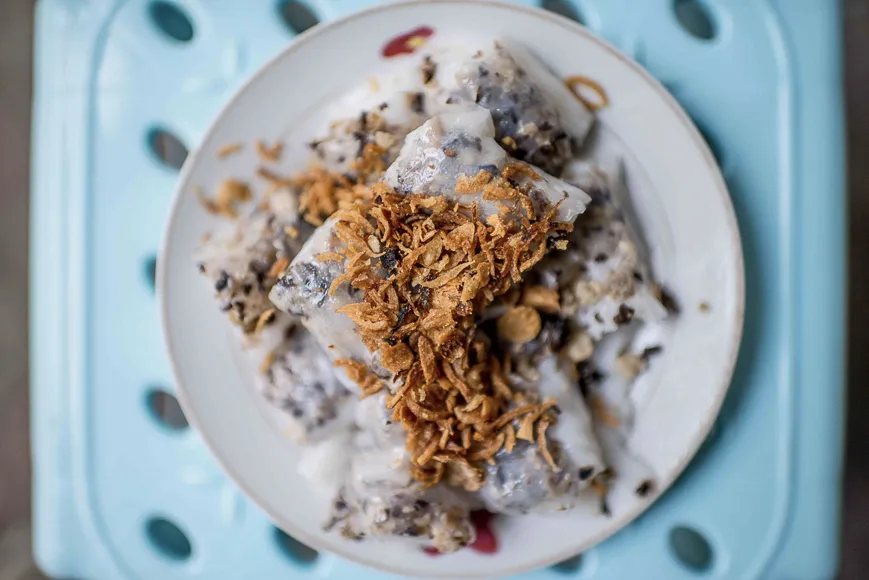 Delicate Banh Cuon, steamed rice rolls filled with pork and mushrooms, a popular breakfast item in Vietnam
Delicate Banh Cuon, steamed rice rolls filled with pork and mushrooms, a popular breakfast item in Vietnam
Try it: Bánh Cuốn stalls and restaurants are common, especially in Hanoi.
Bún Chả Cá: Fish Cake Vermicelli Variations
Bún Chả Cá is a rice vermicelli soup featuring fish cakes (chả cá) as the star ingredient. This dish shows significant regional variation throughout Vietnam, with different cities and provinces having their own unique take on the broth and additional components.
In places like Nha Trang, the soup base is often light and slightly sour, featuring fresh fish broth, tomatoes, and pineapple. The fish cakes themselves can vary in texture and composition, sometimes including bouncy squid cakes or steamed fish paste. The soup is typically served with rice vermicelli, a generous helping of fresh herbs, and sometimes fried green onions or dill. It’s a lighter soup option compared to pho or bun bo hue, showcasing the freshness of the sea.
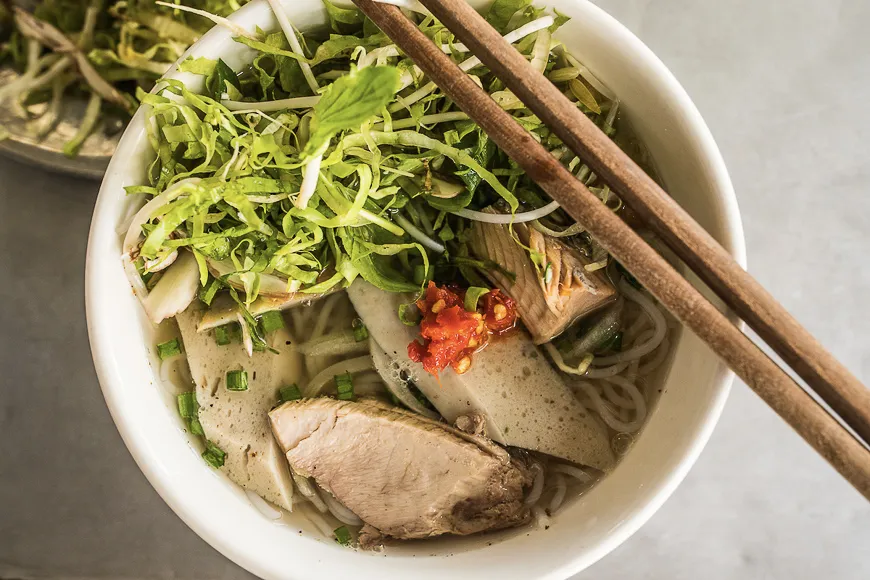 A bowl of Bun Cha Ca, fish cake vermicelli soup, a regional Vietnamese specialty
A bowl of Bun Cha Ca, fish cake vermicelli soup, a regional Vietnamese specialty
Try it: Bún Cá Mịn in Nha Trang is a local favorite for Bún Chả Cá Nha Trang style.
Bún Bò Cuốn Lá Lốt: Grilled Beef in Betel Leaves
Bò Lá Lốt (beef wrapped in betel leaves) is a flavorful Southern Vietnamese dish that combines savory minced beef with the peppery, slightly smoky flavor of lá lốt (betel leaves). The seasoned ground beef (often mixed with garlic and shallots) is rolled tightly in the betel leaves and then grilled over charcoal until fragrant and slightly charred.
The grilled rolls are typically served with rice vermicelli noodles (bún), a variety of fresh herbs, pickled vegetables, and crushed peanuts. It’s often enjoyed by assembling your own rolls, wrapping the bò lá lốt, bún, and herbs in rice paper or lettuce leaves. The dish is always accompanied by a dipping sauce, often a savory nước chấm or sometimes a fermented anchovy sauce (mắm nêm) in the South. The combination of smoky grilled beef, aromatic leaves, fresh components, and dipping sauce is incredibly satisfying.
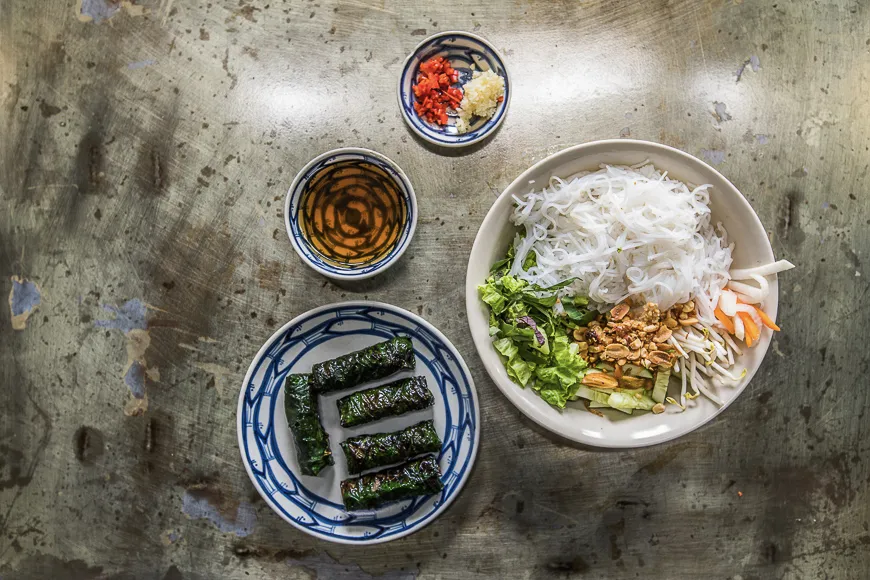 Grilled Bò Lá Lốt, beef wrapped in betel leaves, a popular savory dish in Vietnam
Grilled Bò Lá Lốt, beef wrapped in betel leaves, a popular savory dish in Vietnam
Try it: Look for street vendors or casual eateries in Ho Chi Minh City specializing in grilled items.
Chè: Sweet Treats and Dessert Soups
Chè is a broad category of Vietnamese sweet beverages, puddings, or dessert soups, offering a refreshing end to a meal or a delightful snack. Chè can be served hot or cold, and the ingredients vary widely depending on the region and season.
Cold chè often features a mix of jellies (like pandan or grass jelly), beans (red beans, mung beans), fruits (mango, longan, jackfruit, banana), coconut shreds, and sometimes lotus seeds or tapioca pearls, all served over crushed ice and drizzled with coconut cream or syrup. The textures are often chewy, soft, and crunchy. Hot chè is usually a simpler concoction, focusing on ingredients like beans, sticky rice, or taro in a warm, slightly thickened sweet liquid. The vibrant chè ba màu (three-colored chè) with layers of red beans, yellow mung bean paste, and green pandan jelly is a visually appealing classic.
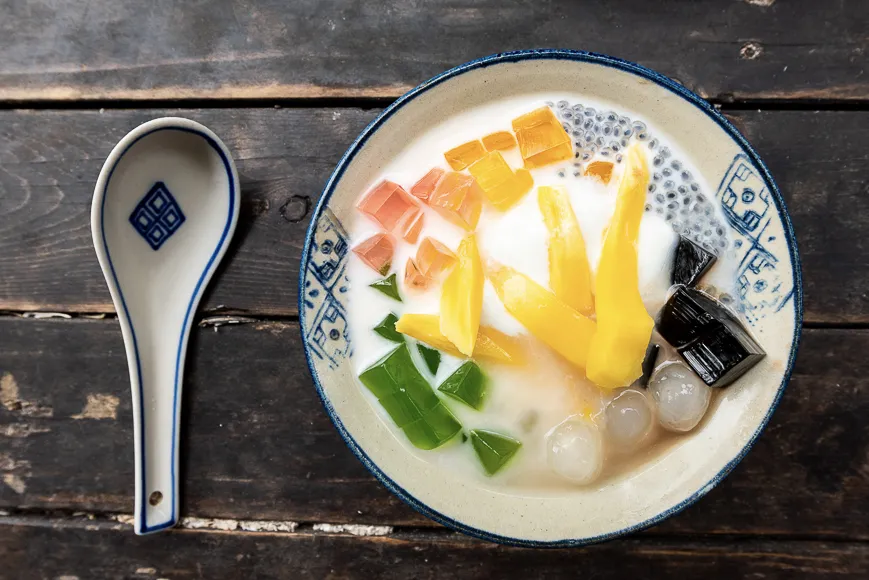 A colorful bowl of Chè, Vietnamese sweet dessert soup, a delightful way to end a meal in Vietnam
A colorful bowl of Chè, Vietnamese sweet dessert soup, a delightful way to end a meal in Vietnam
Try it: Chè stalls are ubiquitous, especially in the afternoons and evenings. Che 95 in Hanoi is a well-known spot.
Beyond the Plate: Experiencing Vietnam’s Food Culture
Understanding what to eat in Vietnam is just the beginning; experiencing how Vietnamese people eat is equally important. The street food scene is integral, offering fresh, affordable, and authentic dishes cooked right in front of you. Don’t be shy to pull up a tiny plastic stool on the sidewalk and join the locals. Communal eating is common, reflecting the country’s strong sense of community. Learning a few basic phrases like “Chúc ngon miệng!” (Enjoy your meal!) will endear you to locals.
Tips for Enjoying Vietnamese Cuisine
- Be Adventurous: Don’t just stick to pho and banh mi. Try regional specialties and street food.
- Observe Locals: See where locals eat – busy spots often indicate good food. Watch how they eat the dish (e.g., how they assemble summer rolls or bun cha).
- Spice Levels: Spice tolerance varies. Central Vietnamese food tends to be spicier. Most places serve chili or chili sauce on the side, allowing you to adjust.
- Fresh Herbs are Key: Don’t ignore the plate of greens! They add essential freshness, flavor, and balance.
- Hygiene: While most street food is safe, choose vendors with high turnover and visible cooking practices. Bottled water is recommended.
Ready to Discover What To Eat In Vietnam?
Exploring Vietnamese food is an unforgettable journey for the senses. Each dish tells a story, connecting you to the country’s rich history, diverse regions, and warm culture. From the comforting depth of pho to the vibrant freshness of goi cuon and the unique charm of regional delights, deciding what to eat in Vietnam opens up a world of delicious possibilities. So pack your bags, bring your appetite, and get ready to eat your way through this incredible country!
Frequently Asked Questions About What To Eat In Vietnam
What is considered the national dish of Vietnam?
Phở is widely regarded as the de facto national dish of Vietnam, beloved throughout the country and internationally recognized.
Is Vietnamese food generally spicy?
Vietnamese cuisine uses chili, but the spice level varies significantly by region. Central Vietnamese food (like Bún Bò Huế) tends to be the spiciest, while Northern and Southern dishes might be less so. Chili is often served on the side.
Is it safe to eat street food in Vietnam?
Generally, yes. Street food is a vital part of the culture. Look for vendors with many customers, clean stalls, and food cooked fresh to order. Trust your instincts and choose busy spots.
What are some popular drinks to try in Vietnam?
Besides the famous Vietnamese coffee (cà phê), popular drinks include fresh juices, sugar cane juice (nước mía), various teas, and local beers (like Bia Hoi or Bia Saigon).
Are there options for vegetarians in Vietnam?
Absolutely. Vietnamese cuisine offers many delicious vegetarian options, often using tofu, mushrooms, and vegetables. Dishes like fresh spring rolls (gỏi cuốn) or some noodle soups can be made vegetarian (chay). Many Buddhist restaurants specialize in vegetarian food.
